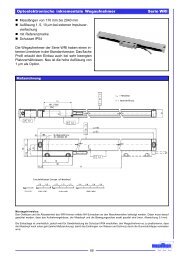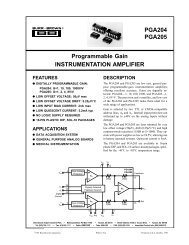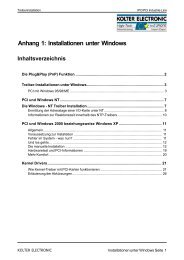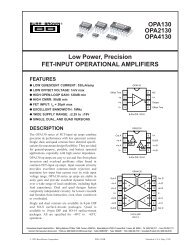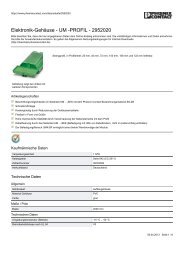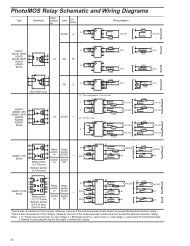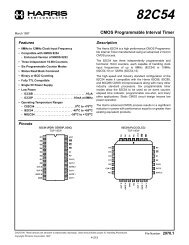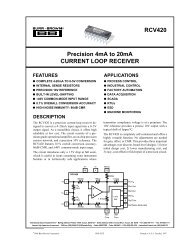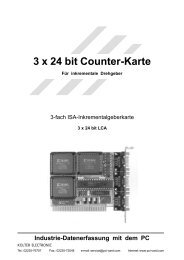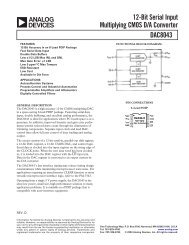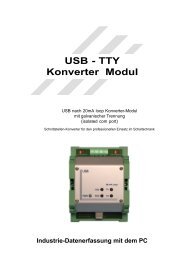Make a â10V to +10V Adjustable Precision Voltage Source
Make a â10V to +10V Adjustable Precision Voltage Source
Make a â10V to +10V Adjustable Precision Voltage Source
You also want an ePaper? Increase the reach of your titles
YUMPU automatically turns print PDFs into web optimized ePapers that Google loves.
®APPLICATION BULLETINMailing Address: PO Box 11400 • Tucson, AZ 85734 • Street Address: 6730 S. Tucson Blvd. • Tucson, AZ 85706Tel: (602) 746-1111 • Twx: 910-952-111 • Telex: 066-6491 • FAX (602) 889-1510 • Immediate Product Info: (800) 548-6132<strong>Make</strong> a –10V <strong>to</strong> <strong>+10V</strong> <strong>Adjustable</strong> <strong>Precision</strong> <strong>Voltage</strong> <strong>Source</strong>By R. Mark Stitt, (602) 746-7445Many situations require a precision voltage source whichcan be adjusted through zero <strong>to</strong> both positive and negativeoutput voltages. An example is a bipolar power supply.Have you ever adjusted your unipolar lab supply down <strong>to</strong>0V, then swapped the output leads and adjusted it back up <strong>to</strong>get a negative voltage output? What happened <strong>to</strong> your circuitwhen the input from the low impedance source went opencircuit? Were you able <strong>to</strong> actually adjust the output <strong>to</strong> 0V, ordid a small voltage offset limit the range? This precisionbipolar voltage source can solve these problems.Perhaps the most obvious implementation of a bipolar voltagesource would be <strong>to</strong> use a bipolar voltage reference.V ININA105Difference Amp25R 125kΩR 225kΩR 3625kΩ3V =10kΩLinear1R 425kΩV OUT= +V IN, Slider at Top of Pot.V OUT= 0V, Slider at Center of Pot.V OUT= –V IN, Slider at Bot<strong>to</strong>m of Pot.OUT+V IN <strong>to</strong> –V INHowever, a simpler solution is <strong>to</strong> use a single voltagereference and a precision unity-gain inverting amplifier. Ifyou use a precision difference amplifier for the unity-gaininverting amplifier, the circuit requires just two chips and apotentiometer.To understand how the circuit works, first consider the –1.0V/V <strong>to</strong> +1.0V/V linear gain control amplifier shown inFigure 1. An INA105 difference amplifier is used in a unitygaininverting amplifier configuration. A potentiometer isconnected between the input and ground. The slider of thepot is connected <strong>to</strong> the noninverting input of the unity-gaininverting amplifier. (The noninverting input of a unity-gaininverting amplifier would normally be connected <strong>to</strong> ground.)With the slider at the bot<strong>to</strong>m of the pot, the circuit is anormal precision unity-gain inverting amplifier with a gainof –1.0V/V ±0.01% max. With the slider at the <strong>to</strong>p of thepot, the circuit is a normal precision voltage follower with again of +1.0V/V ±0.001% max. With the slider in the center,there is equal positive and negative gain for a net gain of 0V/V. The accuracy between –1.0V/V and +1.0V/V will normallybe limited by the accuracy of the pot. <strong>Precision</strong> 10-turn pots are available with 0.01% linearity.The –1.0V/V <strong>to</strong> +1.0V/V linear gain control amplifier hasmany applications. With the addition of a precision +10.0Vreference as shown in Figure 2, it becomes a –10V <strong>to</strong> <strong>+10V</strong>adjustable precision voltage source.FIGURE 1. –1.0V/V <strong>to</strong> +1.0V/V Linear Gain Control Amplifier.+V S2V+REF102Gnd410VOut610kΩLinear23R 125kΩR 325kΩINA105Difference AmpR 225kΩ56V OUT =<strong>+10V</strong> <strong>to</strong> –10VV OUT= <strong>+10V</strong>, Slider at Top of Pot.V OUT= 0V, Slider at Center of Pot.V OUT= –10V, Slider at Bot<strong>to</strong>m of Pot.1R 425kΩFIGURE 2. –10V <strong>to</strong> <strong>+10V</strong> <strong>Adjustable</strong> <strong>Precision</strong> <strong>Voltage</strong> <strong>Source</strong>.© 1990 Burr-Brown Corporation AB-006 Printed in U.S.A. April, 1990
In many instances adjustable voltage sources need the ability<strong>to</strong> drive high-capacitance loads such as power-supply bypasscapaci<strong>to</strong>rs. The additional circuitry needed <strong>to</strong> drive highcapacitance is shown in Figure 3. For stability, keep C LOAD•R 3< 0.5•R 2•C 2. Since access <strong>to</strong> the op amp inverting input isneeded, the unity-gain inverting amplifier is made with anop amp and discrete resis<strong>to</strong>rs. For precision, R 1and R 2mustbe accurately matched. Also, load current flows in R 3. Theresulting voltage drop adds <strong>to</strong> the required swing at theoutput of the op amp. Keep the voltage drop across R 3low—less than 1V at full load—<strong>to</strong> prevent the amplifier outputfrom swinging <strong>to</strong>o close <strong>to</strong> its power-supply rail.For applications with substantial volume (e.g. 5k ea/year) aversion of the INA105 with the op amp inverting inputbrought out is available as a special (2A660). Inquire withmarketing about price and delivery.2V+REF10210VOut6<strong>+10V</strong>R 110kΩR 210kΩC 2V OUT= <strong>+10V</strong>, Slider at Top of Pot.V OUT= 0V, Slider at Center of Pot.V OUT= –10V, Slider at Bot<strong>to</strong>m of Pot.Gnd410kΩLinear0.01µFOPA27R 350Ω+V SV =OUT<strong>+10V</strong> <strong>to</strong> –10VC LOADFIGURE 3. –10V <strong>to</strong> <strong>+10V</strong> <strong>Adjustable</strong> <strong>Precision</strong> <strong>Voltage</strong> <strong>Source</strong> with High Capacitance-Load Drive Capability.The information provided herein is believed <strong>to</strong> be reliable; however, BURR-BROWN assumes no responsibility for inaccuracies or omissions. BURR-BROWN assumesno responsibility for the use of this information, and all use of such information shall be entirely at the user’s own risk. Prices and specifications are subject <strong>to</strong> changewithout notice. No patent rights or licenses <strong>to</strong> any of the circuits described herein are implied or granted <strong>to</strong> any third party. BURR-BROWN does not authorize or warrantany BURR-BROWN product for use in life support devices and/or systems.2



